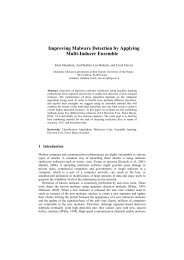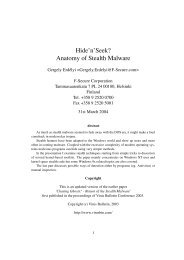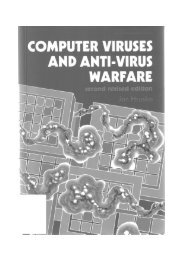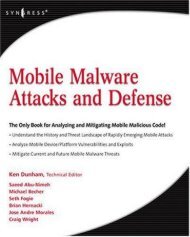Advanced Polymorphic Techniques.pdf - adamas.ai
Advanced Polymorphic Techniques.pdf - adamas.ai
Advanced Polymorphic Techniques.pdf - adamas.ai
You also want an ePaper? Increase the reach of your titles
YUMPU automatically turns print PDFs into web optimized ePapers that Google loves.
PROCEEDINGS OF WORLD ACADEMY OF SCIENCE, ENGINEERING AND TECHNOLOGY VOLUME 25 NOVEMBER 2007 ISSN 1307-6884of EAX, ECX or EDX (which are used by system calls).• The 8 bits register used by 8 bits operations in the codemust be related to a general purpose register (EAX, EBX,ECX or EDX).Then, the expansion can start: it will update registers aswell as accesses to the virus’ global variables. The expansion’sresult is stored in variable ExpansionResult. To controlthe size of expansion, a maximum level of recursivity is firstchosen: it cannot be larger than 3. Then, for each instruction,we increment the recursivity level and we randomly transformit, by using the inverse compression rules. Intermediateinstructions which are generated are also transformed. NOPinstructions are ignored in the compressed code (to avoid anuncontrolled increase of size, after several generations).When an instruction is generated, which uses a temporarymemory address, this memory address points at the Datasection and should not have been allocated for the virusglobal variables nor by any previous instruction in the currentexpansion ch<strong>ai</strong>n. The VarMarksTable array is used to markwhich addresses have been allocated. As for global variables,the allocated address is randomly aligned on one of the first 4bytes. However, this is different in the case of the decryptionroutine since the memory has not been allocated yet (witha call to malloc): the space to be used by intermediateoperations is then the data section that was allocated insidethe host file for the decryption operations.When an instruction uses an immediate value, this valueis computationally decomposed into a sequence of operationsthat finally yield the expected immediate value. This expansionis managed by method Xp_MakeComposedOPImm. Ituses operators ADD, AND, OR and XOR (the SUB operatoris randomly generated when transforming ADD instructions).Here is for instance the algorithm used to generate aMOV Dest, Imm instruction:int v1 = random (), v2 = random ();choose randomly among:* MOV Dest, v1ADD Dest, Imm - v1* MOV Dest, v1 & ImmOR Dest, ((v2 & Imm) ˆ (v1 & Imm)) | (v2 & Imm)* MOV Dest, (v2 & ˜v1) | ImmAND Dest, v1 | Imm* MOV Dest, ˜v1 | ImmAND Dest, v1 | Imm* MOV Dest, v1XOR Dest, v1 ˆ Imm* MOV Dest, ImmIn addition, dead code is inserted, with probability 1/16,after each expansion of an instruction of the compressed code(if this instruction’s opcode was a CMP, TEST, CALL orAPICALL_STORE, amereNOP is inserted):• Instructions that do nothing, like:MOV Reg, RegADD Reg, 0AND Reg, -1...NOP• Tests that always f<strong>ai</strong>l, like:CMP Reg, Reg / JNZ [RandomLabel]• Useless x86 instructions: STC, CLC.7) Reassembly: The last stage consists in assembling thepseudo-code into valid x86 code. When several translationsare possible, the algorithm chooses one at random. Also, shortjumps and long jumps are randomly used (when a short jumpis possible), and jumps at subsequent addresses are stored inarray JmpRelocationTable, in order to be updated inthe end. After completion of this stage, the code is ready forencryption and copy out in the host.D. Randomness <strong>Techniques</strong>1) Pseudo-Random Numbers Generator (PRNG): META-PHOR makes a heavy use of random numbers. It uses its ownpseudo-random numbers generator, with two seeds, seed1and seed2, which are initialized depending on the UNIX datefor seed1 and on the code’s first bytes for seed2. Thena random value is generated using the following algorithm(ror_X denotes right rotation by X bits):int random () {seed1 ˆ= (seed2 + ror_13 (seed1 + seed2));seed2 = (seed1 + ror_17(seed2)) ˆ (seed1 + seed2);return seed1 + ror_17 (seed1 ˆ seed2);}Though this may not be obvious at first sight, the secondseed is very weak, given furthermore that it is initializeddepending on the code’s first bytes which have a low randomness:thus we get, in the worst case, a cyclic generatorof 32 pseudo-random numbers (as soon as seed2 reachesvalue 0x00000000 or value 0xFFFFFFFF). For a randomseed2, a few tests allow to compute the PRNG’s periodabout 40000, which is barely better that the glibc’s generator(random () function), whose statistical properties areparticularly weak and whose period is in the order of 30000.<strong>Polymorphic</strong> viruses usually have their own pseudo-randomgenerator, often of poor quality, which protects them at leastfrom a heuristic alert due to a strong utilization of a system’sPRNG. Yet, some generators exist that are quite powerful andhave a small cost, but their use in polymorphic viruses isscarce. Here are some of them:• Linear Congruential Generator (LCG), of which thefollowing code is an implementation:unsigned int lcg_next (void) {seed *= 1664525u;seed += 1013904223u;return seed;}• Registers generaztors, like Xorshift generators (the followingexample code comes from [10]) and generatorswith linear feedback shift registers (LFSR):/* Galois’ LFSR, with taps 32 31 29 1 */unsigned int lfsrg_next (void) {static unsigned int seed = time (NULL);int i;for (i = 0; i < 32; i++) // shift 32 timesseed = (seed >> 1) ˆ(-(signed int)(seed & 1) & 0xd0000001u);PWASET VOLUME 25 NOVEMBER 2007 ISSN 1307-6884 409 © 2007 WASET.ORG










